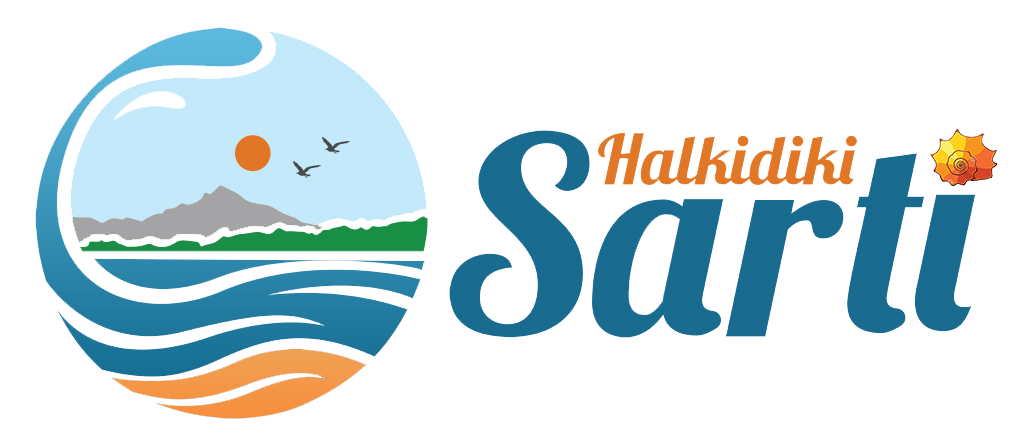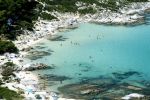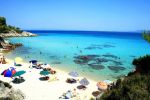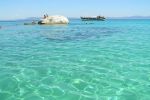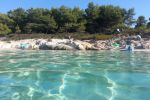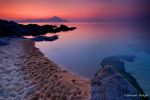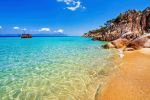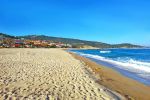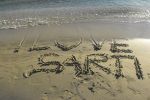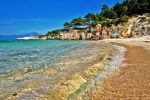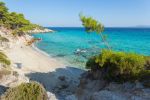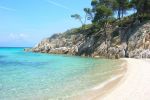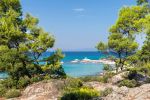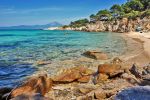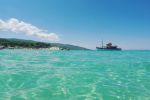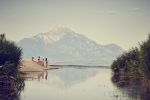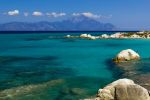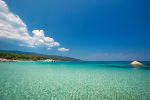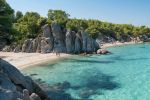Monasteries
The monasteries, if we follow our route driving southeast of Ouranoupolis, are as follows:
Zografou Monaster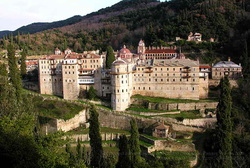
Built in a spot in the woods, at a half an hour walk from the sea, in the 10th century, by monk George, painter by profession, and the monastery was named after him (Zografos means painter). It celebrates the memory of St. George and the famous St. George’s icon that has not been made by human hands can be seen among the relics of the monastery. In the monastery usually Bulgarian monks live.
Konstamonitou Monastery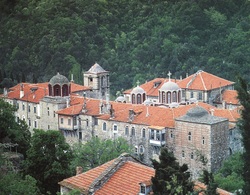
Built in the woods, at a 25 minute walk from the sea, in the 11th century, by a monk who came from Kastamani of Paflagonia. Yet, today’s monastery has been built for the fourth time in 1867, since it had been destroyed many times. It celebrates the memory of the first martyr, Stephanos.
Doheiariou Monastery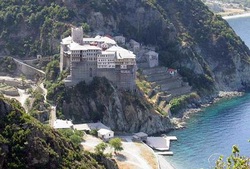
Built next to the seashore, on the southwest side of the Holy Mountain in 966, by Ossios Efthymios and, because it was destroyed by pirates, it was rebuilt and wall painted by painters of the Cretan school in 1578. It celebrates the memory of the Archangels, but it also celebrates Mary, the Mother of God, under the name of “Gorgoepikoos” (one that hears and grants fast).
Xenofonta Monastery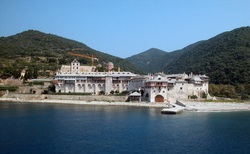
Built next to the sea, in the northwest side of the peninsula, in the 10th century, by Ossios Xenofon. The monastery is well known for its famous icons in mosaic made in the 11th century and for its frescos. It celebrates the memory of St. George.
Panteleimonos Monastery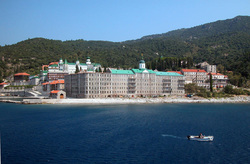
Built on the seaside, in the middle of the coast between the harbor of Dafni and Xenofonta Monastery, in the 12th century, by Russian monks. The monastery looks like a small state having in the middle of it the church of St. Skepi, which is the biggest church of the complex with 8 cupolas and with a bell tower with 33 bells. It celebrates the memory of St. Panteleimon.
Xeropotamou Monastery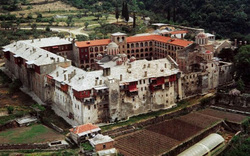
Built on a small plateau above Daphni (the main harbor of Mt. Athos), on the northwest side of the peninsula, in the 10th century, by Ossios Pavlos and wall painted in the end of the 18th century. It celebrates the memory of the 40 Martyrs. The monastery has sixteen chapels and a big collection of icons. Among its relics a big piece of the Holy Cross is included, donated by Konstantinos the Porfyroghenitos, King of the Byzantine Empire.
Monastery of Simonos Petras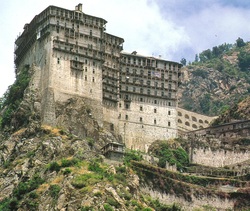
Built like a castle on a rock above the sea, at an altitude of 330 m., in the 14th century, by monk Simon. It has seven floors and next to it we can see the aqueduct of the monastery and beyond it the biggest photovoltaic parc in Mt. Athos that supplies the monastery with solar energy. It celebrates the memory of Christ’s birth.
Monastery of Ossios Grigorios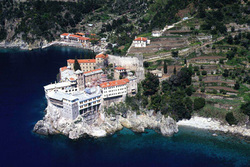
Built on the seaside, in the 13th century, by Ossios Grigorios, in the place where Posseidon’s (Neptune’s) temple was built in the ancient times. It is considered the best organized monastery and above it we can see the water tank and a little further above some energy systems. It celebrates the memory of St. Nicolas.
Dionissiou Monastery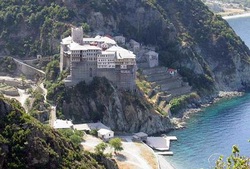
Built on a rock 80 m. high, next to the sea, on the southwest side of the peninsula, by Ossios Dionissios in the 14th century. Destroyed by fire in 1535, the monastery was rebuilt by theovodas Ioannis Petros from Moldavia and decorated with wall paintings by Cretan painters in mid 16th century. It celebrates the memory of the birth of John the Baptist.
St. Pavlos Monastery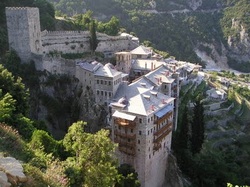
The furthest south monastery in the west side of the peninsula, built on the foot of Athos, in the 10th century, in the place where in 337 the “Monastery of the Mother of God’s entrance to the church” was built. It is the most traditional monastery and its temple is made of sculpted marble.
Monastery of Meghisti Lavra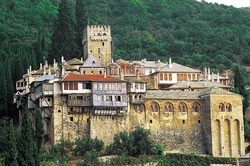
Built on the northeast side of Mt. Athos in 963 by Ossios Athanassios the Athonite. It celebrates the memory of Ossios Athanassios the Athonite. In the courtyard of the Monastery there is a chapel with the old icon of Virgin Mary the so-called Koukouzelissa.
Karakallou Monastery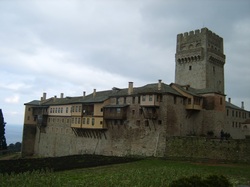
Built on the foot of a hill on the northeast side of Mount Athos, half an hour on foot from the sea. It is said it has existed since the 11th century. Later, it was deserted only to be rebuilt in 1294 by Andronikos 2nd Paleologos, King of the Byzantine Empire. In the 16th century it was renovated by the king of Vlahia Ioannis Petros Rares and his daughter Roxandra bought the glebes of the Monastery. It celebrates the memory of the Apostles St. Peter and St.Paul.
Filotheou Monastery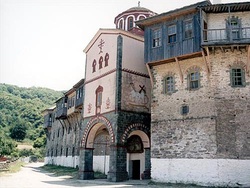
Built in 972, north of Karakallou Monastery at an altitude of 300 m. which long ago was named Fteris Monastery. It celebrates the memory of Virgin Mary’s Annunciation.
Iviron Monastery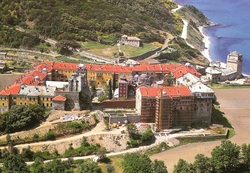
Built near the sea, approximately in the middle of the northeast side of Mt. Athos, by Ivirians (Hiberians or Georgians) followers of Ossios Athanassios the Athonite. It celebrates the memory of the Virgin’s Dormition. In a chapel in the yard of the Monastery the old icon of Virgin the so-called Portaitissa is kept.
Koutloumoussiou Monastery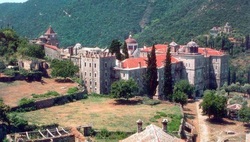
Built next to Karyes, in the middle of the peninsula in 1334 (possibly upon an already existing establishment since 988), by a monk that belonged to the family of Koutloumoussious kings who were Seltzuk Turks. The monastery celebrates the memory of the Savior’s Transfiguration. A relic worth seeing in a chapel of the monastery is the icon of God’s Mother’s Awesome Protection.
Stavronikita Monastery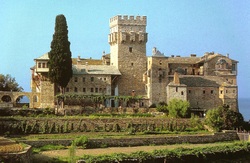
First built as a cell in the 10th century and its tower in the 11th century. As a monastery it was recognized in 1544 and its frescos were made by the famous painter of the Cretan school Theofanis. It celebrates the memory of St. Nicolas.
Pantokratoros Monastery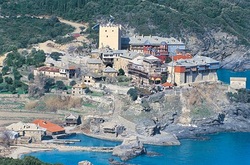
Built on a rocky peninsula of the northeast side of Mt. Athos, in the 14th century by brothers Alexios and Ioannis, officers of the Byzantine Empire. It celebrates the memory of the Savior’s Transfiguration. One can see the famous icon of the Old Lady Virgin Mary (Panaghia Gerontissa) among the relics in the monastery.
Vatopedi Monastery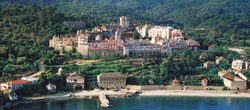
Built on a northeast bay of Mt. Athos by Ossios Athanassios the Athonite’s followers in the end of the 10th century. It celebrates the memory of the Annunciation. The Monastery is the largest and most imposing block of buildings on Mt. Athos and it is decorated by wall paintings of the 14th and mosaics of the 11th century and many old precious relics can be found there.
Esfigmenos Monastery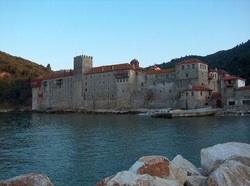
The furthest north monastery in the east side of the peninsula, built probably by monk Theoktistos in the 10th century. It celebrates the memory of Christ’s Ascension.
Helandari Monastery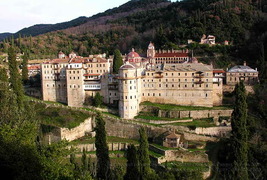
Built in the woods on the northeast side of Mt. Athos, at a half-hour walk from the sea. It was founded by monk George in the 10th century and rendered in 1198 to the Serb king Stephen Nemanja and his son Rachko, who became monks under the names of Symeon and Savas respectively. The monks that have lived since in the Monastery have usually been Serbs. The Monastery celebrates the memory of Virgin’s entrance to the church. Among the many holy relics found in the monastery the icon of the three handed Virgin is worth seeing.
One should mention that in all monasteries there are all sorts of relics, icons, canonicals, crosses, holy relics in reliquaries, silver and gold items, hand written scripts, old and newer printing material.











